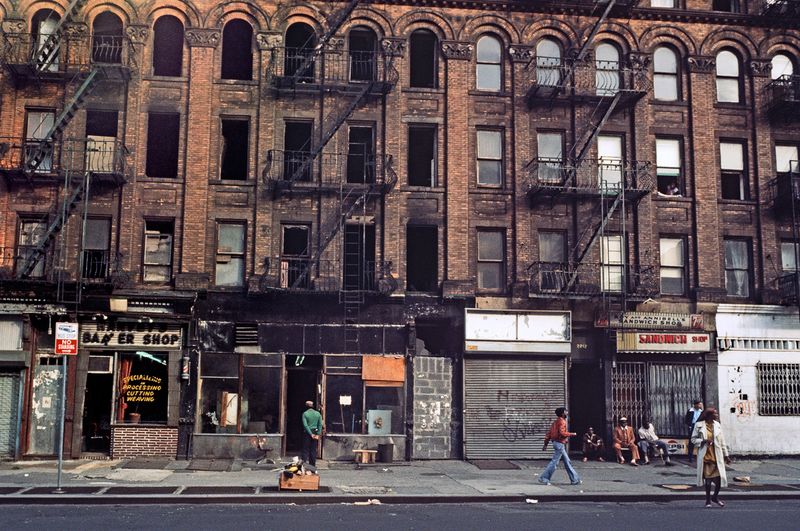THE JOURNAL

Harlem, 1978. Photograph by Mr Alain Le Garsmeur/Getty Images
As we throw our own MR PORTER block party in New York, we look back at the role these impromptu gatherings played in the history of hip-hop.
The block party is a distinctly NYC strain of celebration, and one that has become a well-known trope in popular culture (to the extent that – plug alert – MR PORTER is even throwing one of its own today, on Crosby Street in New York’s Soho). But where did it all come from? While block parties might seem a particularly modern concept, some of the earliest examples of them – or at least, gatherings that called themselves “block parties” – date back to the early 20th century. In 1918, New Yorkers mounted block-based get-togethers to commemorate residents who’d gone to fight in WWI. On 7 May 1945, when rumours broke out that Germany had bowed out of WWII, New York Mayor Fiorello Henry La Guardia had to angrily demand that New Yorkers go home or back to work after a block party broke out on Times Square. By the 1960s, the migration of West Indian and Hispanic immigrants to New York had created communities whose block parties celebrated their own cultural identities – which, of course, led to the celebration of new music, and the creation of new sounds.
It’s in this way that New York’s block party culture gave birth to hip-hop, though there are disputes as to who the genre’s true originator might be. It’s most likely there were actually several key pioneers who may have had their feet in multiple boroughs, visiting relatives spread across the city. Some will argue that it was all down to forgotten innovators such as Brooklyn’s Grandmaster Flowers, who mixed funk and blues records together in sequence at parties back in the late 1960s. That said, the South Bronx is widely considered hip-hop’s birthplace.

South Bronx Park Jam, 1984. Photograph by Mr Henry Chalfant
For many in the Bronx during the late 1960s and very early 1970s, mobility was hindered by significant gang problems, with gangs like the Ghetto Brothers, Savage Skulls and Black Spades running their respective neighbourhoods. In late 1971, however, a gang truce – the Hoe Avenue Peace Meeting – liberated what was once a patchwork of guarded territories, breaking down the barriers between blocks. Then came the parties, in which many gang members went on to make a different kind of impact. Mr Shan Nicholson’s 2010 documentary, Rubble Kings, chronicles how Puerto Rican nationalists the Ghetto Brothers (whose co-founder, the guitarist Mr Benjamin Melendez, formed a band of the same name) played their own brand of Latin funk at block parties that illicitly tapped into streetlights to power their speakers. The Black Spades, under the influence of division leader and DJ Mr Afrika Bambaata, span off into the Universal Zulu Nation, which proved integral to popularising hip-hop and giving it its first council. While reggae wasn’t always the sound of choice for youthful partygoers in the area, its sound-system culture of vast speakers reigning victorious over rival sounds had been imported to some degree. In his book, Can’t Stop, Won’t Stop, Mr Jeff Chang describes the block party — an autonomous zone of sorts that distracted from a ghetto’s grim realities — as “the space of possibilities” for young participants.
A key figure to emerge from this backdrop was Mr Clive Campbell, aka DJ Kool Herc, a Jamaican-born South Bronx teenager who started his career throwing back-to-school parties with his sister in their building’s recreation room. Mr Campbell, a funk and soul devotee, came up with the idea, core to hip-hop, of the “break” – that is, isolating a snappy, percussive segment within a track, and repeating it. Before digital audio, the only way to extend these breaks to a satisfying length was playing two copies of the same record at the same time – a technique Mr Campbell perfected. At his parties, which grew and grew along with his popularity in the early 1970s, his friend Coco (later Coke La Rock) took to the mic, rhyming along with the music. And soon, Mr Campbell’s reputation inspired rivals. As DJs across boroughs sought out the perfect breaks, unlikely records were given new life, from songs by British rock acts to bongo cover versions of popular tunes. All were selected for that crucial isolated moment that could rock a crowd. The sound — thrown together by a multi-cultural community formerly kept at arm’s length from the velvet ropes of club-land — was a mix of anything that worked, honed at block parties, plus jams at youth centres, schoolyards and parks.

Still from Rubble Kings, 2015 – documentary directed by Mr Shan Nicholson. Photograph by Mr Alejandro Olivera/ Saboteur Media
New York’s hip-hop culture was bolstered by blackout of July 13-14, 1977, which left most of the city in darkness. As pioneering DJ Disco Wiz recalls in the book Yes, Yes, Ya’ll, a night of looting electronic stores for equipment may well have been a catalyst for the following cultural explosion: “After the blackout, you had a DJ on every block.” By 1979, a compromised version of this party sound would find its way onto vinyl. Pioneer status is a scant reward for some forgotten creators who sowed the seeds for what’s now a multi-billion-dollar industry, but those moonlit sessions altered music forever.
Of course, in 2016, the New York block party is still popular, but there’s a little more paperwork behind it. Now it takes an application to the Street Activity Permit Office plus local community board, NYPD, Fire Department and Department of Sanitation’s approval, as well as a money order for $45 to get the party started. Not quite the zeitgeist moment of 1973, but the New York City that stands tall 43 years later is a very different beast indeed.